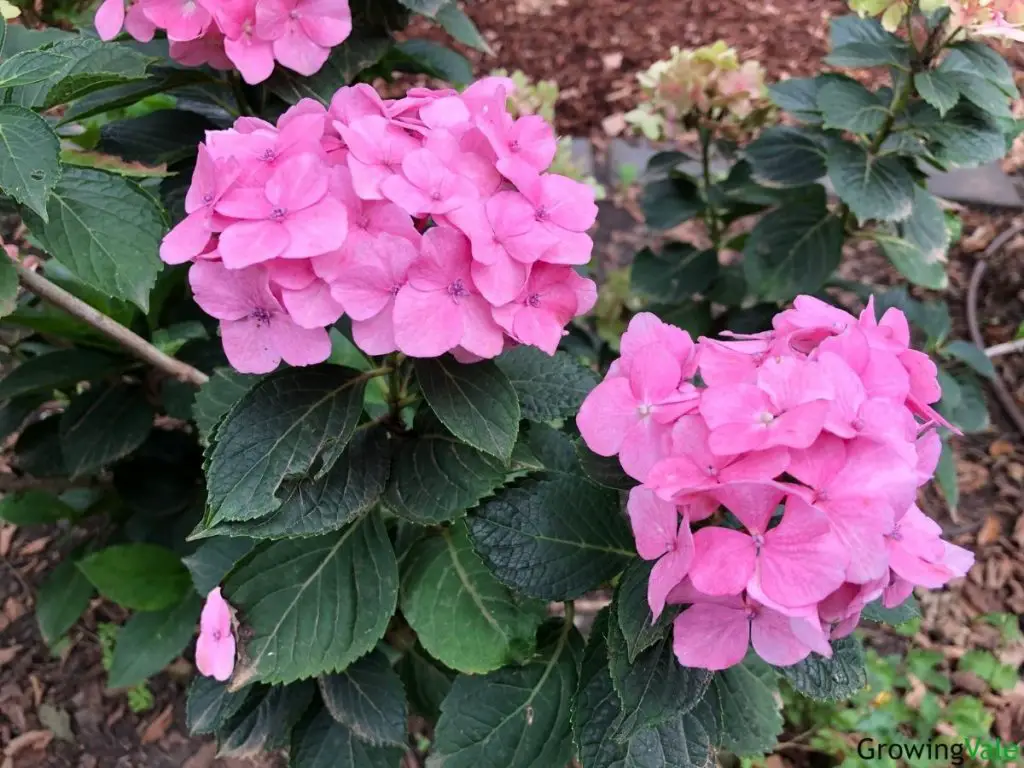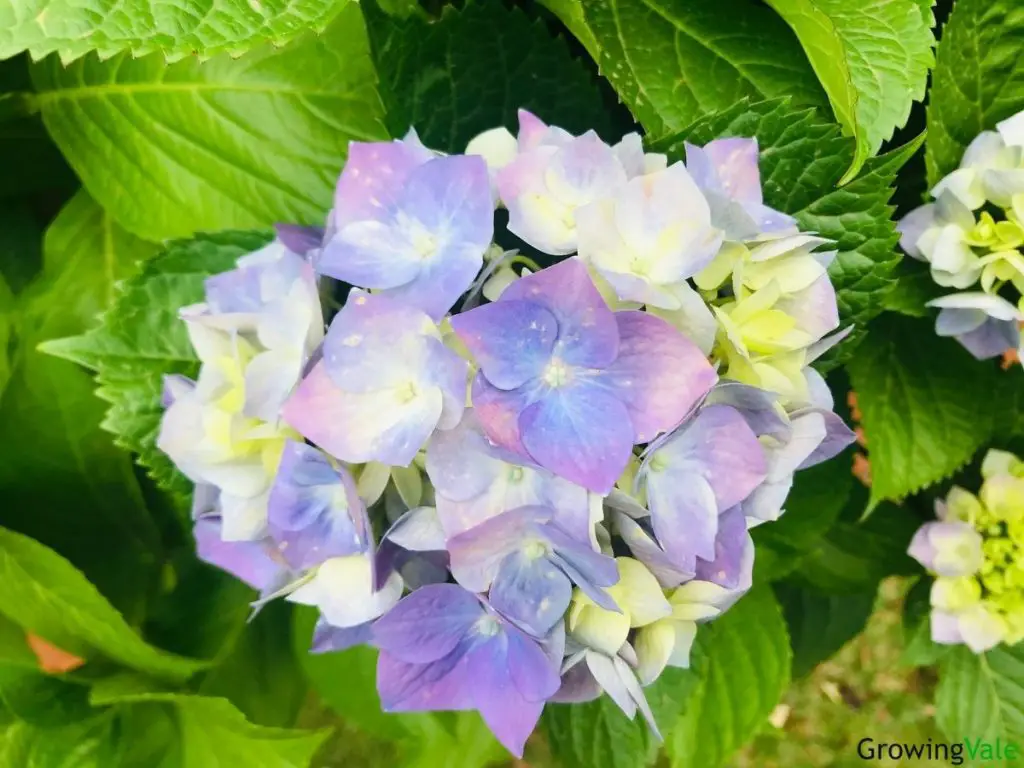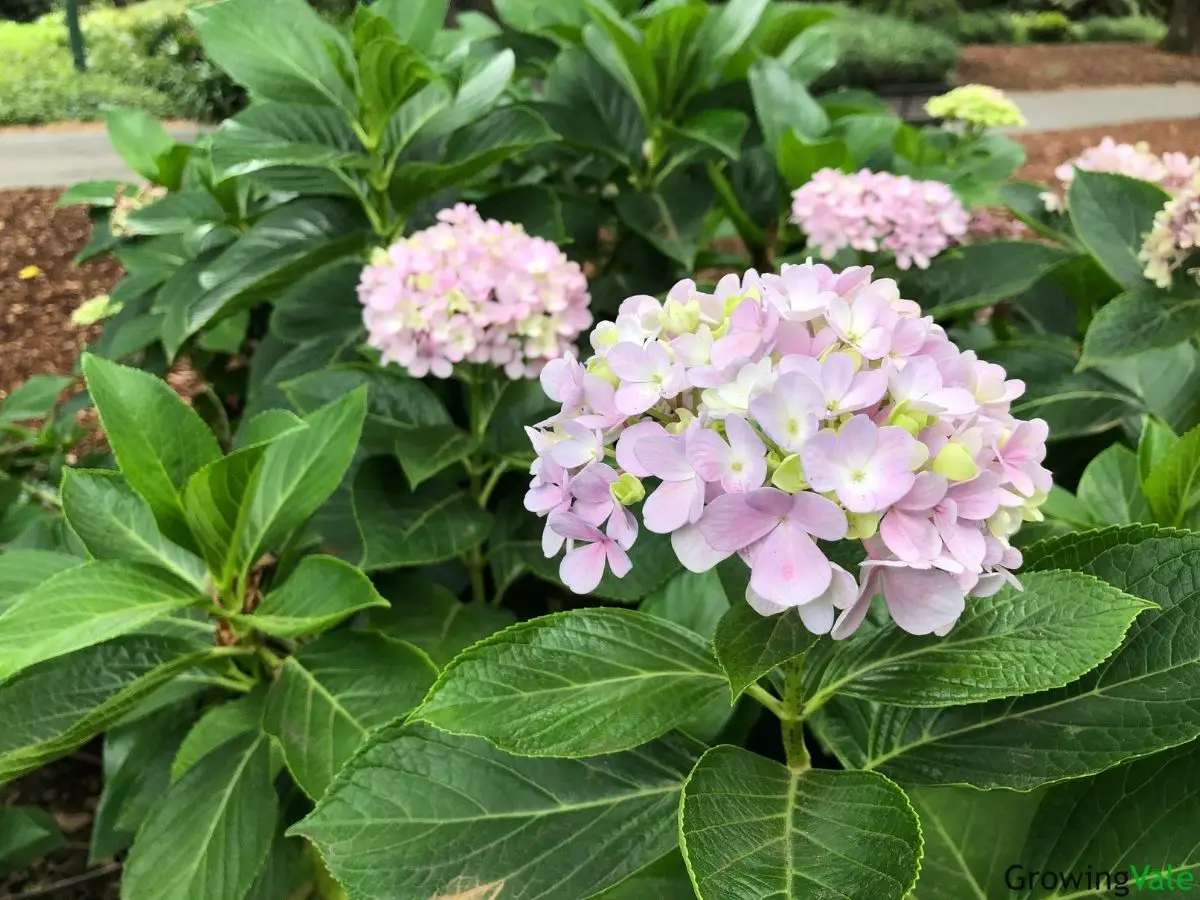Hydrangea macrophylla or bigleaf hydrangea is the most common hydrangea shrub and includes mopheads and lace-cap varieties.
Bigleaf hydrangeas are a gardener’s favorite. A perennial with long-lasting flowers which are great for cutting, it is also very popular with florists. If the flowers are pink or blue, you can switch the colors by changing the acidity or alkalinity of your soil.
History
Bigleaf hydrangeas are native to Japan and other parts of Asia. They arrived in Europe in the mid-1800s. Horticulturists in France fell in love with them, and they became known as French hydrangeas.
Plant Facts
| Scientific name | Hydrangea macrophylla |
| Common names | Bigleaf hydrangea, French hydrangea, Hortensia, Lacecap Hydrangea, Mophead Hydrangea, |
| Genus | Hydrangea |
| Family | Hydrangeaceae |
| Height | 3 to 6 feet |
| Width | 3 to 6 feet |
| USDA Plant Hardiness Zone | 6 to 11 |
| Origin | Japan, China, Korea, Southeast Asia |
| Flower colors | Pink, Purple, Blue, White |
| Blooming season | Summer |
| Plant/Flower special features | Cut flower, long-lasting, dried flower |
How to Plant and Grow Bigleaf Hydrangeas
Many traditional bigleaf hydrangeas need plenty of space. If you only have a small garden, consider a newer cultivar, designed for growing in a pot.

Where to plant
H. macrophylla needs to be planted in an area that avoids the strong afternoon sun, but somewhere it can still receive morning sunshine. If your hydrangea bush doesn’t receive enough sun, it will have few or no flowers.
Bigleaf hydrangeas are hardy in USDA zones 5 to 9. A pot-grown plant is a good choice if you are in a colder region, as it can be moved indoors during a cold spell.
When to plant
The best time to plant your hydrangea is in fall or spring, but you may need to protect your shrub against a late frost.
How to plant
Before planting, remove the root ball from the pot and soak it. Depending on the size of the plant, the hole should be around 2 feet in diameter. If the soil is poor, add in some compost to enrich it. Likewise, if too heavy, mix some sand into it.
When you plant the hydrangea, spread out the roots and make sure that the soil around the edges of the hole is soft and crumbly.
Water well after planting and make sure that the top of the root ball is level with the surface of the soil. A thick layer of organic mulch around the base of the plant will help to retain moisture in the soil and also suppress weeds.
After planting, leave a few weeks for the hydrangea to become used to its new environment before applying any fertilizer.
Planting Hydrangeas In Containers
Bigleaf hydrangeas also do well when planted in containers, but you need to choose a large pot with good drainage. The soil in a pot will dry out quicker than in the ground, even with mulch.
A pot-grown hydrangea will be more work as you need to move the potted hydrangea out of the sun to prevent it from wilting, water more frequently, and protect from the frost.
A dwarf variety of bigleaf hydrangea won’t need to be pruned often nor repotted so frequently.

Care and Maintenance
All varieties of hydrangeas are easy-care, but there are some tips to help you get the best from your plant.
Soil
Hydrangeas are not fussy but do need well-drained soil, otherwise, the roots can rot, and the hydrangea plant will die.
If you want to keep a blue bigleaf hydrangea shrub blue, you should use ericaceous compost.
Watering and Feeding
In summer, a newly planted bigleaf hydrangea needs to be watered regularly. Once it is established, its roots will be able to absorb water easier.
Potted hydrangeas will need more watering. In a container, the soil will dry out far quicker, particularly if the pot is made of plastic.
When using fertilizer, make sure you choose a product designed for hydrangeas. This will be one that is not high in nitrogen, as too much nitrogen in the mix will promote leaf growth but not flowers.
To keep your hydrangea flowers blue (or to change them from pink to blue) you need to use a fertilizer in the early spring which is low in phosphorus.
After fertilizing, give it a good drink to reduce the possibility of fertilizer burn.
Sunlight
The hydrangea doesn’t need sunlight to survive, but without sufficient sunlight, your hydrangea won’t bloom.
The heat of the afternoon sun should be avoided, so plant in a spot where your shrub will receive plenty of morning sunlight.
Temperature and Humidity
The Hydrangea macrophylla will survive USDA zones 6 to 9. However, a prolonged cold spell in late spring can damage or kill the tender flower buds.
To avoid the hydrangea wilt, the base of the plant needs to be kept cool during hot weather. The soil should be moist, but not too wet.
Bigleaf hydrangeas should not be left to stand in waterlogged soil. If the roots are left in saturated soil for an extended period, the plant will rot and die.
Pruning
Bigleaf hydrangea bushes don’t have to be pruned and will flower without any pruning.
Almost all H. macrophylla varieties bloom on old wood. During fall or late summer, the flower buds start to develop. If you prune your bigleaf after these buds have formed, you will lose the following year’s flowers.
If you wish to prune your hydrangeas, you need to do so when the flowers finish. This will preserve the following year’s flowers and also encourage new growth.
The best time to cut back a hydrangea is very early in the spring when you can also cut off any old flower heads that remain and remove any dead wood. But just make sure you don’t prune it hard, or you will lose flowers.
Repotting and Transplanting
Even a dwarf plant needs space to spread, so choose a pot that is about 3 inches bigger than the root ball. Water well before removing the hydrangea from its pot, and again once you have transplanted it.
Keep some original compost to mix with the new, to help the plant establish itself in its new growing medium.

How to Propagate Bigleaf Hydrangea Shrubs
Probably the easiest way to propagate hydrangeas is by layering. Because there will be low-lying branches on your hydrangea shrub, it is very easy to peg these into the ground during the spring.
Cover with a little compost, and after a few weeks, tiny roots should have started to form. Once properly developed, detach the cuttings from the main branches and pot them up. Leave them to grow on until the autumn before planting out.
If you prefer, make softwood stem cuttings from your bigleaf hydrangea shrubs in the spring. Take cuttings around 4 inches long from tender stems. Cut below a leaf node and remove all but the top two leaves from your cutting and cut these in half.
You can dip the cuttings into hormone rooting powder to speed up the rooting process, but the hydrangeas will still root without it. Once you have covered the stem with the powder, make a small hole and place the cuttings in the potting compost with a pencil or stick.
If you put your cuttings in a cold frame, mist regularly. You want to keep them moist but not too soggy. They should be left in a light, warm environment, but out of direct sunlight or extreme heat.
Although the cuttings will start to root after just a couple of weeks, don’t disturb them until they are around two months old. By then, they will have healthy roots, and you can plant them out.
Pest and diseases
The great thing about French hydrangeas is that there aren’t many pest problems. Not many diseases or pests will seriously harm your plants. Aphids, weevils, spider mites, and beetles can infest, but even large numbers can usually be reduced by a spray jet from a powerful hose. These insects won’t do more damage than causing unsightly blotches on the leaves.
Prolonged periods of cool, wet weather (or overwatering) may cause Botrytis or other fungal diseases. Symptoms include blotches on the leaves and a furry coating on the flowers.
Bigleaf hydrangeas can suffer more from powdery mildew than other species.
The best way to minimize this disease is to make sure that you don’t leave dead or decaying plant debris lying around the plant.
The most serious potential problem for your bigleaf hydrangea shrub is root rot. This is often caused by allowing the plant to sit in waterlogged soil. Prevent this by lightening your soil if necessary, as once root rot takes hold, there is no cure.
Uses of French Hydrangeas
These plants produce beautiful, large, showy blooms which are much loved by florists. French hydrangea flowers make extravagant displays when used as cut flowers.
The blooms can even be dried so that you can enjoy their blooms well into fall.
Common Varieties and Cultivars of Hydrangea macrophylla
The two most commonly grown varieties of H. macrophylla are the showy mophead hydrangeas and the equally attractive, but more delicate lacecap hydrangeas.
Newer cultivars flower more reliably and have a tidier habit than their predecessors.
Some attractive, versatile bigleaf hydrangeas are listed below.
- H. macrophylla ‘Blue Billow’
A pretty light blue lace-cap hydrangea, which is also one of the most cold-hardy varieties available. This cultivar is tolerant of cold down to USDA zone 4. Early to flower, not too tall (around 4 feet), this variety will even flower if planted in the shade.
- H. macrophylla ‘Let’s Dance Diva!’
Another lacecap and another sure winner, this bigleaf hydrangea bush will only grow to 3 feet tall. Its flowers are up to 10 inches wide, pink or blue depending on the soil pH level. Less cold hardy than “Blue Billow”, but will still grow in USDA zones 5 to 9.
- H. macrophylla ‘Big Daddy’
This is one of the recent reblooming mophead varieties which produces enormous pink or blue flowers which are as wide and as round as dinner plates!
This cultivar blooms on both new and old wood, which means that in summer, its flowers appear on old wood, and in fall they appear on new growth. Reblooming hydrangeas such as “Big Daddy” have profuse, endless flowers admired by all.
- H. macrophylla ‘Endless Summer’
This is another excellent choice of hydrangea bush and another mophead which flowers on both old and new wood. This shrub produces an abundance of densely packed flowers that last all summer. It has a tidy habit, and will not grow more than 4 feet in either height or spread.
Conclusion
Bigleaf hydrangeas include many hundreds of cultivars, all of which are long-lived. They produce magnificent annual displays of summer flowers. Whether you choose a large, showy mophead, or a delicate lace cap, there is a bigleaf for you!

